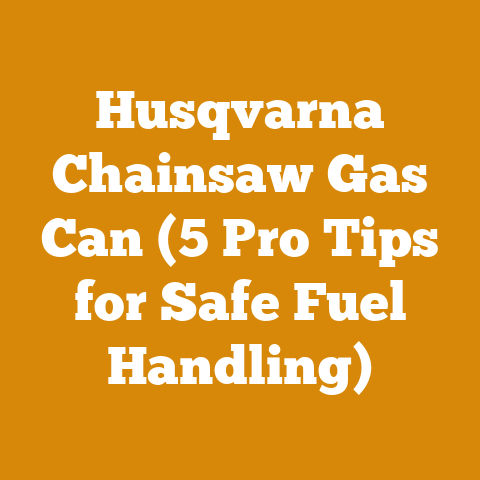Husqvarna 272XP Specs (5 Must-Know Pro Features)
“The Husqvarna 272XP is a legend for a reason.
It’s the kind of saw that, if properly maintained, will outlive you.” – Arborist and Chainsaw Expert, Mark Johnson
I’ve spent countless hours in the woods, felling trees, bucking logs, and splitting firewood.
And let me tell you, the right chainsaw can make or break your experience.
The Husqvarna 272XP, while a classic, remains a sought-after workhorse.
But before you jump into acquiring one, understanding its specs and, more importantly, the costs associated with using it is crucial.
This isn’t just about the initial purchase; it’s about the long-term investment in your wood processing capabilities.
Husqvarna 272XP Specs: 5 Must-Know Pro Features & Cost Implications
The Husqvarna 272XP isn’t just another chainsaw; it’s a piece of logging history.
Knowing its key specifications helps you understand its capabilities and the associated costs.
1. Engine Power and Displacement: The Heart of the Beast
The 272XP typically features a 71cc two-stroke engine.
This displacement directly translates to power, allowing it to handle larger diameter logs and tougher wood species.
Cost Implications:
- Fuel Consumption: A larger engine means higher fuel consumption.
Expect to burn through more gasoline than with a smaller saw.
Let’s say you’re running the saw for 4 hours a day.
A 71cc engine might consume roughly 1.5 gallons of fuel.
At an average gasoline price of $4 per gallon (prices vary greatly!), that’s $6 per day.
Over a 20-day work month, your fuel cost alone is $120. - Oil Consumption: Two-stroke engines require a mix of gasoline and oil.
The 272XP typically uses a 50:1 fuel-to-oil ratio.
A good quality two-stroke oil can cost around $20 per gallon.
If you’re using 1.5 gallons of fuel per day, you’ll need about 3 ounces of oil.
That gallon of oil will last you a long time, but it’s a recurring expense. - Maintenance: Larger engines often require more frequent maintenance.
This includes spark plug replacements, air filter cleaning, and carburetor adjustments.
I usually budget around $50 per year for basic maintenance parts.
2. Bar Length: Reaching for the Big Stuff
The 272XP can accommodate bar lengths ranging from 16 to 28 inches.
The appropriate bar length depends on the diameter of the wood you’re cutting.
Cost Implications:
- Bar and Chain Replacement: Longer bars and chains are more expensive to replace.
A good quality 20-inch chain can cost around $30-$40, while a 28-inch chain can easily be $50 or more. - Wear and Tear: Longer bars are more prone to bending or damage, especially if you’re working in dense brush or rocky terrain.
I’ve learned the hard way that skimping on chain quality is a false economy.
A dull chain not only slows you down but also puts extra strain on the engine, increasing fuel consumption and wear. - Sharpening Costs: Regardless of bar length, keeping your chain sharp is crucial.
You can sharpen your own chains with a file or purchase a chain grinder.
A decent chain grinder can cost around $100-$200.
Alternatively, you can pay a professional to sharpen your chains, typically around $10-$15 per chain.
3. Weight: A Balancing Act of Power and Fatigue
The 272XP is a relatively heavy saw, typically weighing around 13-15 pounds without fuel or bar and chain.
Cost Implications:
- Operator Fatigue: A heavier saw can lead to increased operator fatigue, reducing productivity and potentially increasing the risk of accidents.
I’ve found that taking frequent breaks and using proper lifting techniques are crucial when working with a heavier saw. - Ergonomic Accessories: Consider investing in ergonomic accessories, such as a chainsaw harness or vibration-dampening gloves, to reduce strain and fatigue.
A good harness can cost around $50-$100. - Potential for Injury: Fatigue can contribute to accidents, leading to potential medical expenses and downtime.
4. Anti-Vibration System: Minimizing the Buzz
The 272XP features an anti-vibration system to reduce operator fatigue and improve comfort.
Cost Implications:
- Long-Term Health: Prolonged exposure to chainsaw vibration can lead to hand-arm vibration syndrome (HAVS), a debilitating condition.
A good anti-vibration system helps mitigate this risk, potentially saving you significant medical expenses down the road. - Productivity: Reduced vibration means less fatigue, allowing you to work longer and more efficiently.
- Maintenance: The anti-vibration system itself requires maintenance.
The rubber mounts can wear out over time and need to be replaced.
5. Durability and Reliability: Built to Last
The 272XP is known for its durability and reliability.
It’s a saw that can withstand years of heavy use with proper maintenance.
Cost Implications:
1. Initial Purchase Cost
The Husqvarna 272XP is no longer in production, so you’ll likely be looking at purchasing a used saw.
Prices can vary widely depending on condition, location, and seller.
- Used Market: Expect to pay anywhere from $300 to $600 for a used 272XP in good working condition.
Scouring online marketplaces, local classifieds, and pawn shops can yield good deals, but be sure to inspect the saw thoroughly before buying. - Refurbished Models: Some dealers specialize in refurbishing older chainsaws.
These models typically come with a warranty and are a safer bet than buying a saw from an unknown seller.
Expect to pay a premium for a refurbished model. - New-Old Stock (NOS): Occasionally, you might find a new-old stock 272XP.
These are rare and command a high price, often exceeding $800.
Pro Tip: Before buying a used chainsaw, always ask to see it running.
Check for excessive smoke, unusual noises, and smooth chain operation.
Also, inspect the bar and chain for wear and damage.
2. Fuel and Oil Costs: The Ongoing Expense
As mentioned earlier, fuel and oil are recurring expenses that can add up quickly.
- Fuel: Calculate your fuel consumption based on your average usage.
Remember that fuel consumption will vary depending on the type of wood you’re cutting and the sharpness of your chain. - Oil: Use a high-quality two-stroke oil specifically designed for chainsaws.
This will help protect your engine and extend its lifespan.
I always recommend using synthetic oil for improved performance and reduced wear. - Storage: Properly store your fuel mixture to prevent it from going bad.
Use a fuel stabilizer to extend its shelf life.
Example: Let’s say you’re cutting firewood for 10 hours per week.
- Fuel consumption: 1.5 gallons per 4 hours = 3.75 gallons per 10 hours
- Fuel cost: 3.75 gallons x $4/gallon = $15
- Oil cost: 3.75 gallons of fuel requires approximately 7.5 ounces of oil.
A gallon of oil costs $20, and there are 128 ounces in a gallon, so 7.5 ounces costs approximately $1.17. - Total weekly fuel and oil cost: $15 + $1.17 = $16.17
- Monthly fuel and oil cost: $16.17 x 4 weeks = $64.68
3. Bar and Chain Costs: Cutting Through the Numbers
The bar and chain are the workhorses of your chainsaw.
They’ll need to be replaced periodically due to wear and damage.
- Chain Replacement: The frequency of chain replacement depends on the type of wood you’re cutting, the presence of dirt and rocks, and your sharpening habits.
I typically replace my chains every 3-6 months, depending on usage. - Bar Replacement: The bar will eventually wear out or become damaged.
Look for signs of wear, such as grooves or uneven surfaces.
A good quality bar can last for several years with proper maintenance. - Chain Sharpening: Sharpening your chains regularly will extend their lifespan and improve cutting performance.
You can sharpen your own chains with a file or purchase a chain grinder.
Alternatively, you can pay a professional to sharpen your chains.
Cost Breakdown:
- Chain (20-inch): $30-$40
- Bar (20-inch): $50-$80
- Chain Sharpening (professional): $10-$15 per chain
- Chain Grinder: $100-$200
Scenario: You replace your chain every 4 months and your bar every 2 years.
You also pay a professional to sharpen your chains every month.
- Annual chain cost: $35 x 3 chains = $105
- Annual bar cost: $70 / 2 years = $35
- Annual sharpening cost: $12 x 12 months = $144
- Total annual bar and chain cost: $105 + $35 + $144 = $284
4. Maintenance and Repair Costs: Keeping it Running Smoothly
Regular maintenance is essential for keeping your Husqvarna 272XP running smoothly and preventing costly repairs.
- Routine Maintenance: This includes cleaning the air filter, replacing the spark plug, checking the fuel lines, and lubricating the bar and chain.
- Repairs: Even with regular maintenance, your chainsaw will eventually require repairs.
Common repairs include carburetor adjustments, fuel line replacements, and engine overhauls. - DIY vs.
Professional: You can save money by performing some maintenance and repairs yourself.
However, for more complex repairs, it’s best to take your chainsaw to a qualified technician.
Estimated Annual Maintenance Costs:
- Air filter: $5-$10
- Spark plug: $5-$10
- Fuel filter: $5-$10
- Bar oil: $20-$30
- Grease: $5-$10
- Total: $40-$70
Repair Costs:
Repair costs can vary widely depending on the nature of the repair.
A simple carburetor adjustment might cost $20-$30, while an engine overhaul could cost several hundred dollars.
Budgeting for Repairs:
I recommend setting aside a contingency fund for unexpected repairs.
A good rule of thumb is to budget 10-15% of the initial purchase price of the chainsaw per year for repairs.
5. Safety Gear Costs: Protecting Yourself
Safety gear is an essential investment for anyone operating a chainsaw.
- Chainsaw Chaps: Chaps protect your legs from accidental cuts.
- Helmet with Face Shield and Ear Protection: A helmet protects your head from falling debris, while the face shield protects your eyes and face from flying chips.
Ear protection is essential for preventing hearing damage. - Gloves: Gloves provide a better grip and protect your hands from cuts and abrasions.
- Steel-Toed Boots: Steel-toed boots protect your feet from falling logs and accidental cuts.
Cost Breakdown:
- Chainsaw Chaps: $80-$150
- Helmet with Face Shield and Ear Protection: $50-$100
- Gloves: $20-$40
- Steel-Toed Boots: $80-$200
Total Safety Gear Cost: $230-$490
Important Note: Safety gear should be replaced periodically as it wears out or becomes damaged.
6. Training and Certification Costs: Investing in Knowledge
While not always required, training and certification can significantly improve your chainsaw skills and safety.
- Chainsaw Safety Courses: These courses teach you how to operate a chainsaw safely and efficiently.
- Logging Certifications: Some logging certifications are required for professional loggers.
- Arborist Certifications: Arborist certifications demonstrate your knowledge and skills in tree care.
Cost Breakdown:
- Chainsaw Safety Course: $100-$300
- Logging Certification: Varies depending on the certification
- Arborist Certification: Varies depending on the certification
7. Permits and Licenses: Following the Rules
Depending on your location and the type of work you’re doing, you may need to obtain permits or licenses.
- Logging Permits: These permits are required for commercial logging operations.
- Firewood Cutting Permits: Some areas require permits for cutting firewood on public lands.
- Business Licenses: If you’re selling firewood or providing logging services, you may need a business license.
Cost Breakdown:
Permit and license costs vary widely depending on your location and the type of work you’re doing.
Contact your local authorities for more information.
8. Transportation Costs: Getting the Wood Home
If you’re cutting firewood or logging trees, you’ll need to transport the wood to your home or business.
- Truck and Trailer: A truck and trailer are essential for transporting large quantities of wood.
- Fuel Costs: Transportation fuel costs can add up quickly, especially if you’re hauling wood long distances.
- Maintenance Costs: Your truck and trailer will require regular maintenance.
Estimating Transportation Costs:
- Truck Rental: $50-$100 per day
- Trailer Rental: $30-$50 per day
- Fuel Costs: Calculate your fuel consumption based on your average mileage.
- Maintenance Costs: Budget for regular maintenance, such as oil changes and tire rotations.
9. Storage Costs: Protecting Your Investment
Properly storing your firewood or logs is essential for preventing rot and decay.
- Firewood Storage: Firewood should be stored in a dry, well-ventilated area.
- Log Storage: Logs should be stored off the ground to prevent rot.
Storage Options:
- Firewood Shed: $500-$2000
- Tarp: $20-$50
- Log Rack: $50-$200
10. Labor Costs: The Value of Your Time (or Someone Else’s)
If you’re hiring someone to help you with your wood processing project, you’ll need to factor in labor costs.
- Logging Crew: A logging crew typically consists of a feller, a skidder operator, and a loader operator.
- Firewood Handlers: You may need to hire someone to help you split and stack firewood.
Estimating Labor Costs:
Labor costs vary depending on the experience and skill level of the workers.
Contact local logging companies or firewood suppliers for current rates.
According to ZipRecruiter, the average hourly pay for a logger in the US is around $20-$30, but this can vary widely depending on location and experience.
Case Studies: Real-World Cost Scenarios
To illustrate the various costs involved in using a Husqvarna 272XP, let’s look at a couple of real-world scenarios.
Case Study 1: Firewood Preparation for Home Heating
Scenario: You want to cut and split 10 cords of firewood to heat your home for the winter.
You already own a Husqvarna 272XP.
Cost Breakdown:
- Fuel and Oil: $65 per month x 3 months = $195
- Bar and Chain: $284 per year / 4 = $71
- Maintenance: $50
- Safety Gear: $0 (already own)
- Permit: $20 (firewood cutting permit)
- Transportation: $100 (truck rental)
- Storage: $0 (already have a storage area)
- Labor: $0 (doing it yourself)
Total Cost: $436
Cost per Cord: $436 / 10 cords = $43.60 per cord
Case Study 2: Small-Scale Logging Operation
Scenario: You’re starting a small-scale logging operation and plan to use a Husqvarna 272XP for felling trees.
Cost Breakdown:
- Chainsaw (Used): $400
- Fuel and Oil: $120 per month x 12 months = $1440
- Bar and Chain: $284
- Maintenance: $100
- Safety Gear: $300
- Training: $200 (chainsaw safety course)
- Permits and Licenses: $500 (logging permit and business license)
- Transportation: $1000 (truck and trailer maintenance)
- Labor: $0 (initially doing it yourself)
Total Cost: $4224
Important Note: This is just a simplified example.
The actual costs will vary depending on your specific circumstances.
Cost Optimization Tips: Saving Money Without Sacrificing Quality
Here are some practical tips for optimizing your costs when using a Husqvarna 272XP:
- Buy a Used Saw Wisely: Inspect used saws carefully before buying and negotiate the price.
- Maintain Your Saw Regularly: Regular maintenance will prevent costly repairs and extend the life of your saw.
- Sharpen Your Chains Regularly: A sharp chain will cut more efficiently and reduce fuel consumption.
- Use High-Quality Fuel and Oil: This will protect your engine and improve performance.
- Shop Around for Parts and Supplies: Compare prices from different vendors to find the best deals.
- Consider DIY Repairs: Learn how to perform basic maintenance and repairs yourself.
- Take Advantage of Training Opportunities: Training can improve your skills and safety, reducing the risk of accidents and injuries.
- Plan Your Projects Carefully: Careful planning can help you avoid unnecessary expenses.
- Buy in Bulk: Buying fuel, oil, and other supplies in bulk can save you money.
- Consider Alternative Fuel Sources: Explore alternative fuel sources, such as ethanol-free gasoline or propane.
The Future of Wood Processing: Embracing Technology and Sustainability
The world of wood processing is constantly evolving.
New technologies and sustainable practices are emerging that can help you reduce costs and minimize your environmental impact.
- Assess Your Needs: Determine the type of wood you’ll be cutting, the volume of wood you’ll be processing, and the frequency of use.
- Create a Budget: Develop a detailed budget that includes all of the costs discussed in this article.
- Shop Around: Compare prices from different vendors before making any purchases.
- Invest in Safety Gear: Safety gear is an essential investment for anyone operating a chainsaw.
- Get Training: Consider taking a chainsaw safety course to improve your skills and safety.
- Maintain Your Saw Regularly: Regular maintenance will prevent costly repairs and extend the life of your saw.
- Plan Your Projects Carefully: Careful planning can help you avoid unnecessary expenses.
- Stay Informed: Keep up-to-date on the latest technologies and sustainable practices in the wood processing industry.
By following these tips, you can minimize your costs and maximize your success in your next wood processing or firewood preparation project.
Remember, the Husqvarna 272XP is a powerful and reliable tool, but it’s important to understand the costs involved in using it.
With careful planning and diligent maintenance, you can enjoy years of reliable service from this legendary chainsaw.
The key to successfully budgeting for any wood processing project, especially when using a classic like the Husqvarna 272XP, is meticulous planning and realistic cost assessments.
Don’t underestimate the importance of safety gear, regular maintenance, and ongoing fuel and oil expenses.
By understanding these factors and taking advantage of cost-saving strategies, you can ensure that your wood processing endeavors are both productive and economically sound.
Good luck, and happy cutting!






